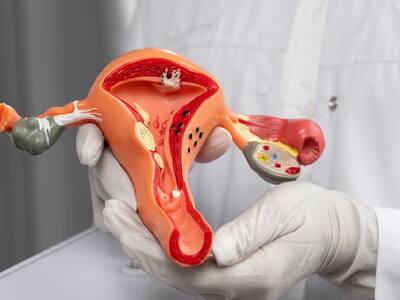
The growing prevalence of uterine cancer among younger women poses a significant threat to women’s health worldwide.
Uterine cancer, while relatively less prevalent in India than in Western countries, still accounts for 1.2% of all cancers in Indian women. According to GLOBOCAN 2020, India reported an estimated 16,413 new cases of uterine cancer, contributing to a global total of 417,367 diagnoses in 2020. In recent years, there has been a concerning increase in early-onset cancers, including uterine cancer, affecting individuals under 50. This article delves into the rising incidence of uterine cancer among younger women, its causes, the importance of early detection, and the need for awareness and prevention.
Understanding Uterine Cancer
The uterus, also known as the womb, is an essential reproductive organ situated between the bladder and the rectum. Its primary functions include nurturing the fertilized egg, supporting the fetus during gestation, and maintaining the menstrual cycle. The inner lining tissue layer of the uterus is called the endometrium, which undergoes cyclical changes under the influence of two key hormones: estrogen and progesterone. An imbalance in these hormones can trigger cancerous transformations in endometrial cells, with over 90% of uterine cancers originating in the endometrium. Less common types of uterine cancer include uterine papillary serous carcinoma, clear cell carcinoma, leiomyosarcoma, uterine sarcoma, and carcinosarcoma.
Factors Leading To Rise Of Uterine Cancer Among Younger Women
Traditionally considered a disease affecting postmenopausal women, the increase in uterine cancer cases among younger women is alarming. Key factors contributing to this rise include:
Obesity: The prevalence of obesity among younger women has escalated due to sedentary lifestyles, increased stress, poor dietary habits, and irregular sleep patterns. Obesity leads to elevated estrogen levels in the absence of regular ovulation, increasing the risk of uterine cancer. Polycystic Ovarian Syndrome (PCOS), which is associated with a three-fold increased risk for endometrial cancer, is noteworthy in this context.
Environmental Exposures: Changes in environmental exposure to carcinogens, such as pollution and toxins, can play a role in the development of uterine cancer.
Medications and Radiation: Certain medications, like tamoxifen, and pelvic radiation exposure can increase the risk of uterine cancer. Prior medical conditions like breast or ovarian cancer and diabetes may also heighten the risk.
Genetic Predisposition: Genetic factors, including hereditary conditions like Lynch Syndrome, can contribute to an elevated risk of uterine cancer, along with other cancers.
Significance Of Early Detection
The focus on early detection of uterine cancer is crucial because patients with localized disease at diagnosis have a favourable prognosis. Surgery alone can often result in a complete cure when uterine cancer is localized, boasting a 95% 5-year relative survival rate. However, if the cancer has spread, additional treatments such as radiation therapy and chemotherapy may be necessary. Once the cancer has reached other parts of the body, the 5-year relative survival rate drops significantly to just 18%.
READ RELATED: Coffee’s Unexpectedly Healthful Benefits
Spotting early symptoms, such as abnormal vaginal bleeding or spotting, is essential for early detection. In younger women, these symptoms may be dismissed or attributed to irregular periods, leading to delayed diagnosis. Additionally, young women of childbearing age may hesitate to opt for a hysterectomy, which is a standard treatment for uterine cancer, due to their desire to have children. Fertility-sparing options exist, including the use of a progesterone-delivering IUD, but early detection remains critical to their success. The management of such cases requires the expertise of a multidisciplinary team, including gynecologic oncologists and oncofertility experts.
Other unusual symptoms of uterine cancer can include pelvic pain, abnormal vaginal discharge, unexplained weight loss, and changes in bladder or bowel habits. Many young women are unaware of these signs, resulting in delayed diagnosis and treatment. Therefore, raising awareness about risk factors, symptoms, and available resources is essential to empower women to recognize warning signs, seek prompt medical attention, and make informed decisions.
Uterine cancer may not frequently make headlines, but its growing prevalence among younger women poses a significant threat to women’s health worldwide. By increasing awareness, promoting early detection, and addressing risk factors, we can work together to save lives and enhance the health and well-being of women everywhere.
The article is authored by Dr Sravanthi Nuthalapati, Consultant Gynaecologic Oncologist, Karkinos Healthcare.
Total Wellness is now just a click away.
Follow us on
Don’t Miss Out on the Latest Updates.
Subscribe to Our Newsletter Today!
window.addEventListener(‘load’, (event) => {
$(‘#commentbtn’).on(“click”,function(){
(function(d, s, id) { var js, fjs = d.getElementsByTagName(s)[0]; if (d.getElementById(id)) return; js = d.createElement(s); js.id = id; js.src = “//connect.facebook.net/en_US/sdk.js#xfbml=1&version=v2.3”; fjs.parentNode.insertBefore(js, fjs);}(document, ‘script’, ‘facebook-jssdk’));
$(“.cmntbox”).toggle();
});
});









